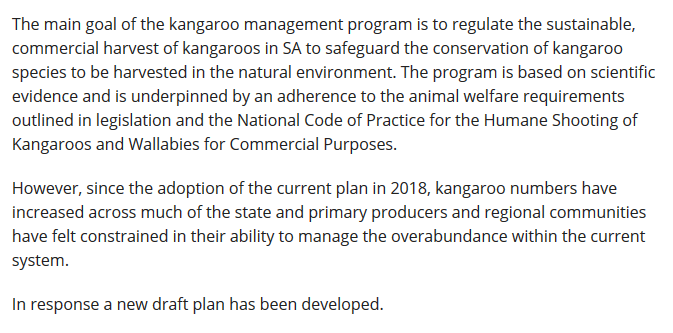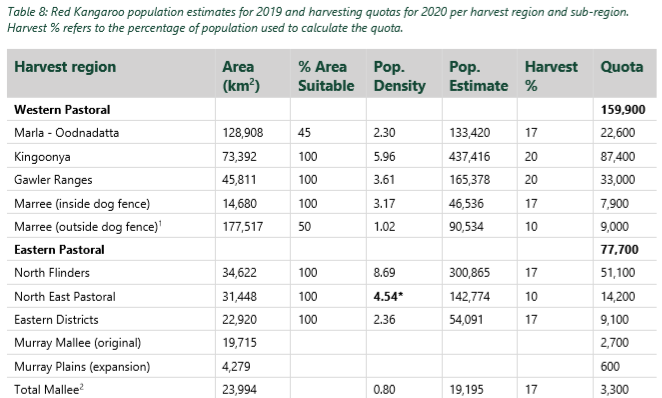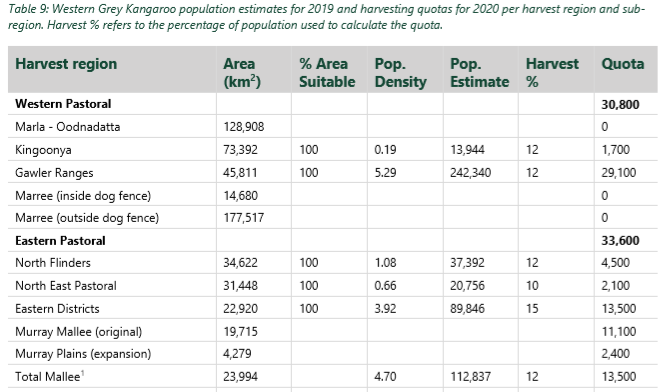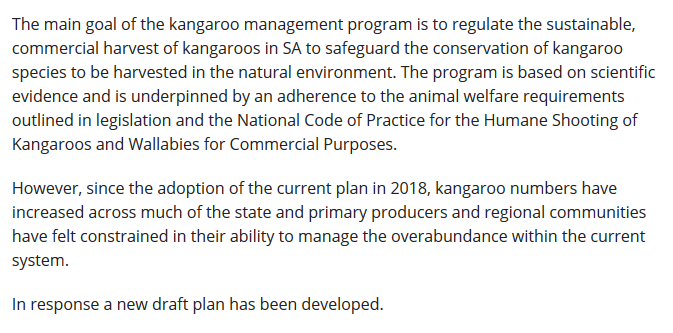The South Australian Department for Environment and Water (DEW) produced the draft South Australian Commercial Kangaroo Management Plan 2020-2024. According to the South Australian Government’s Your Say website:

The statements on the SA Government’s Your Say website are false. For instance, since 2018 kangaroo numbers have decreased across much of the state.
In the harvest zone known as Marree (inside dog fence), red kangaroo numbers crashed from 261,010 in 2018 to 46,536 in 2019. Numbers fell by 82% – a whopping decline.
Similar devastating declines are recorded in the North-east Pastoral. In 2018, red kangaroo numbers were 492,476. A year later, in 2019, red kangaroos numbers were 142,774. Numbers fell by 71% – a massive decline.
In 2018, in the harvest zone of Marla – Oodnadatta, red kangaroos numbers were 171,125. By 2019, red kangaroo numbers fell to 133,420 – declining by 22%. A smaller decline but extremely serious.
The quasi-extinction density is five kangaroos per square kilometre, the nominal value of kangaroo densities taken to indicate the effective loss of the species. Critical minimum densities are not clearly defined but populations below 2 kangaroos per square kilometre would generally be considered at risk of extinction (Hacker et al, 2004).
In the Marla – Oodnadatta harvest zone, from 2018 to 2019, red kangaroo densities fell from 1.3 red kangaroos per square kilometre to 1.03 red kangaroos per square kilometre. According to Hacker et al (2004), these kangaroos are considered at risk of extinction. In spite of the risk, the 2020 quota of kangaroos allowed to be harvested in this zone is 22,600. Instead of suspending the commercial harvest of red kangaroos at risk of extinction, the DEW increased the quota from 10% to 17%.

Red kangaroo numbers declined dramatically in every harvest zone with the exception of the zones that were expanded in size. Expanding the size of the zone was the reason for the increase in red kangaroo numbers in these zones.
The Murray Mallee and Mid-north/Yorke harvest zones were both expanded in size for 2020. Even with the expanded size, in the Murray Mallee, red kangaroo densities are 0.79 kangaroos per square kilometre – well below 2 kangaroos per square kilometre which is generally considered as being at risk of extinction. In the Mid-north/Yorke expanded zone, red kangaroo densities are 0.40 kangaroos per square kilometre – well below 2 kangaroos per square kilometre which is generally considered as being at risk of extinction. Yet, the commercial harvest of kangaroos continues in these zones at a rate of 17% of the total populations.
The commercial harvest of kangaroos should be suspended in 2020. Instead, it’s business as usual with kangaroo populations at risk of extinction being hunted at rates of 17% of their entire at risk population.
The common euro wallaby wasn’t surveyed in any zone during 2019, which means that current numbers are unknown. Without surveys of the harvest zones, the DEW has no way of knowing if numbers increased or decreased.
In three of the harvest zones, western grey kangaroo numbers are zero. Two zones on the Eyre Peninsula were not surveyed in 2019, so numbers of western grey kangaroos are unknown.

In the harvest zone known as Kingoonya, in 2018, western grey kangaroo populations were 30,091 – a density of 0.41 kangaroos per square kilometre, meaning these kangaroos are at risk of extinction. In 2019, numbers dropped to less than half – 13,944. The density fell to 0.18 kangaroo per square kilometre, increasing the risk of extinction. The commercial harvest of these kangaroos continues at 12% or 1,700 kangaroos.
In the Gawler Ranges, in 2018, the number of western grey kangaroos were 378,857. In 2019, the number fell to 242,340.
In the North Flinders, in 2018, the number of western grey kangaroos were 47,778. In 2019, the number fell to 37,392. The density fell from 1.38 to 1.08 – meaning that these kangaroos are at risk of extinction. Yet, the commercial harvest continues in this zone at a rate of 12% or 4.500.
In the North-east Pastoral, in 2018, the number of western grey kangaroos were 91,828. In 2019, the number fell to 20,756. The density fell from 2.91 to 0.66 – meaning that these kangaroos are at risk of extinction. Yet, the commercial harvest continues at a rate of 10% or 2,100 kangaroos.
In the Eastern Districts, in 2018, the number of western grey kangaroos were 154,022. In 2019, the number fell to 89,846. The density fell from 6.71 to 3.91. Five kangaroos per square kilometre is considered quasi-extinction. The number of western grey kangaroos in the Eastern Districts has fallen below quasi-extinction, placing them at greater risk of extinction. Yet, the commercial harvest continues at a rate of 15% or 13,500 kangaroos.
The story continues. Western Grey kangaroo numbers declined dramatically in every harvest zone with the exception of the zones that were expanded in size. Expanding the size of the zone was the reason for the increase in western grey kangaroo numbers in these zones.
Community input was sought on the draft South Australian Commercial Kangaroo Management Plan 2020-2024 from 6 June 2019 to 6 September 2019. The SA Government’s Your Say website sought input through online discussion, a survey, email feedback. The contents of the website were deliberately false, deceptive and prejudicial intended to influence and lead public opinion. They included:

The whole premise of the South Australian Kangaroo Management Plan 2020-2024 is false. The DEW asked for public consultation on how to manage and monitor abundant kangaroo species. Their own estimates reveal that kangaroo numbers are in serious decline and that most regional populations are at risk of extinction. Neither the decline, nor the risk of extinction was mentioned in the South Australian Kangaroo Management Plan 2020-2024.

Again, the DEW is misleading the public. If the main goal of the kangaroo management plan was to regulate the sustainable, commercial harvest of kangaroos in SA to safeguard the conservation of kangaroo species, the commercial harvest of kangaroos would have been suspended in response to drastic declines in kangaroo populations and too many densities falling below 2 kangaroos per square kilometre.
The program might be based on scientific evidence but that evidence is being ignored.
Critical minimum densities are not clearly defined but populations below 2 kangaroos per square kilometre would generally be considered at risk of extinction (Hacker et al, 2004).
Five harvest zones in South Australia have densities of fewer than 2 kangaroos per square kilometre. According to Hacker et al (2004), the commercial harvest of kangaroos in these zones is ecologically risky.
Kangaroo populations increase gradually. Actual wild population growth rates (PGR) are a maximum of ~8-10% per annum under good conditions (Arnold et al, 1991).
All of the harvest zones have quotas between 10% and 20% per annum. In the best case scenario, kangaroos reproduce at 8% to 10% per annum. During prolonged drought, kangaroos do not reproduce at all. Sustaining a commercial harvest of double the reproduction rate is impossible.
The scientific evidence is at odds with the South Australian Kangaroo Management Plan 2020-2024.
The National Code of Practice for the Humane Shooting of Kangaroos and Wallabies for Commercial Purposes is not worth the paper it’s written on. The Code is not monitored or policed. Ex-kangaroo shooters admit that they do not follow the Code because no one polices it. The Code is a document intended to fool the public and serves no other purpose. We’ve tried to get the police and the Department of Natural Resources to investigate the inhumane shooting of local kangaroos but no one will do anything. They are simply not interested.
As we’ve already discussed in detail, kangaroo numbers have declined drastically across the state. Kangaroos are not overabundant. In fact, many populations are below the quasi-extinction rate of five kangaroos per square kilometre.
The whole South Australian Kangaroo Management Plan 2020-2024 is false, deceptive and misleading. The whole premise of the Management Plan is increased kangaroo numbers creating an overabundance. The DEW’s own estimates reveal that the opposite is the case – kangaroo numbers have drastically declined, placing most regional populations on the brink of extinction.
We have been through the whole South Australian Kangaroo Management Plan 2020-2024, only to conclude that conservatively at least 50% of the document is false, deceptive or misleading. The results of our study is downloadable from the below link.
